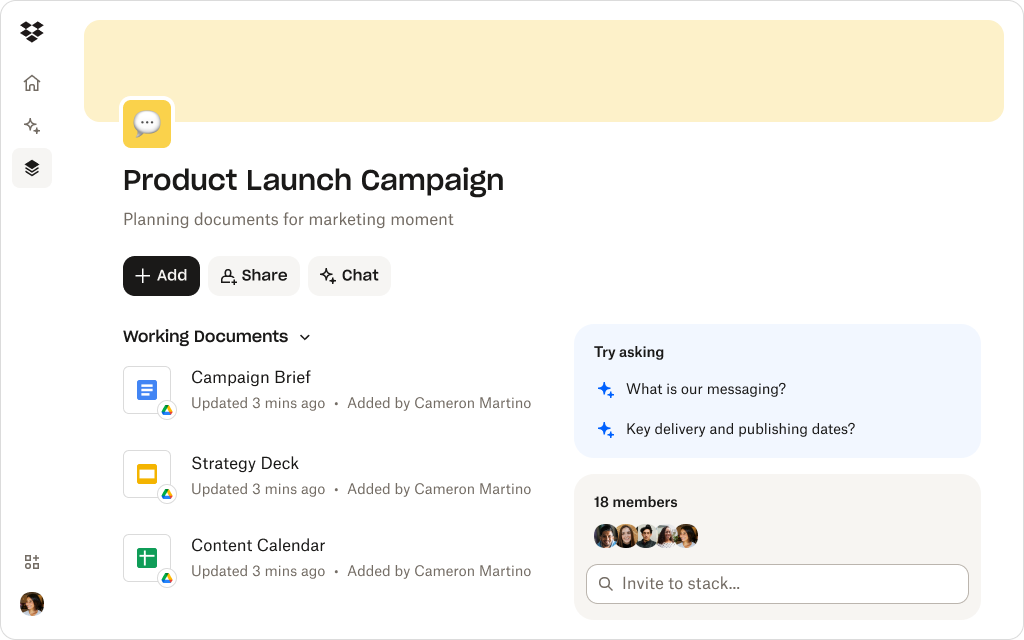
The more channels you manage, the easier it is for your message to drift.
Every new platform feels like another place to reach your audience, tell your story, and build connections. But with every added channel comes the challenge of keeping your message consistent.
What starts as a unified brand voice can quickly become marked by problems, such as:
- Different tones
- Mixed visuals
- Competing messages
- Overstretched teams and timelines
Suddenly, your brand doesn’t sound like a consistent, single voice out there. Social posts emphasize one thing, product pages another, and email campaigns something else. It’s the natural side effect of chasing speed, scale, and having multiple contributors working across disconnected tools.
That’s why alignment matters in an age of AI. Dropbox Dash helps teams find, reference, and reuse the right messaging in every channel—keeping stories sharp, cohesive, and unmistakably you, no matter where it appears.
Why multichannel content management is so hard
Marketers know the pressure of creating consistent messaging across social, email, ads, web platforms, and other areas—all while keeping assets fresh and on brand. It’s a lot to handle in a fast-paced environment.
As campaigns expand, teams juggle hundreds of files, versions, and creative requests. Each platform has unique requirements, from aspect ratios and copy limits to tone variations and tracking codes.
That can result in a sprawling, unnavigable maze of folders, drafts, and links scattered across tools like Google Drive, Slack, Dropbox, and project management apps.
It’s a real issue that impacts teams hard. Research from Content Marketing Institute found that 63% of marketers say maintaining consistency across multiple platforms is one of their top content challenges.
That challenge compounds as campaigns scale—especially for small teams with limited resources and time.

The cost of scattered assets
In a perfect world, every file, deck, and visual would live in one place—easy to find, easy to update, and easy to share. But as teams grow and workflows multiply, assets start drifting. They live in different locations and don’t talk to each other. That means great work gets lost, and momentum can grind to a halt.
When assets live across different platforms, three issues tend to surface:
- Duplication: Teams recreate existing assets because they can’t find the originals. The more versions you make, the harder it becomes to know which one’s right.
- Delays: Approvals and revisions get buried in chat threads or emails. Deadlines slip while teams chase feedback that’s scattered across tools.
- Drift: Slight variations in copy or visuals lead to off-brand messaging. Every inconsistency chips away at credibility and audience trust.
Each problem wastes time and money.
According to Asana’s Anatomy of Work Global Index 2023, workers spend up to 58% of their time on “work about work”—tasks like searching for information, managing files, and switching between tools.
For marketers, that’s time not spent on strategy, creativity, or engagement. And when assets get lost or duplicated, it’s not just productivity at stake—it’s consistency, reputation, and results.
AI-powered features in tools like Dash help reverse that trend—bringing every asset, team, and context together in one connected workspace so great ideas never get lost in the shuffle.
How teams can simplify multichannel workflows
Managing content across multiple channels is a balancing act. Every platform has its own format, timeline, and audience expectations—so it’s easy for teams to get buried in tools, tabs, and approvals. What starts as smart channel diversification can quickly spiral into duplication, delay, and brand drift.
To keep campaigns consistent and collaboration smooth, teams need a structure that scales. Here are a few ways to streamline content across multiple marketing channels, teams need to:
- Centralize access—bring all creative assets—visuals, copy, and files—into one searchable hub. This ensures everyone works from the same source of truth
- Standardize versions—create a naming convention and archive system to prevent outdated assets from resurfacing
- Automate discovery—use AI and search tools to surface the latest, approved materials quickly
- Integrate tools—instead of switching between platforms, use a connected workspace that links apps like Dropbox, Slack, and Google Drive
- Build feedback loops—centralized comments and approvals ensure version control without lengthy email chains
These steps make multichannel content management more scalable—without requiring teams to add more tools or people. With Dash, teams can go even further—connecting every file, channel, and comment thread into one intelligent workspace where context travels with the content, and consistency happens automatically.

How Dash brings channels and content together
Dropbox Dash helps teams keep content aligned across channels by connecting everything—from file storage to creative workflows—into one central hub.
Here’s how Dash simplifies multichannel content management:
- Universal search—Dash finds assets across Dropbox, Google Drive, and other connected apps, so no campaign materials ever go missing
- Stacks—group channel-specific content (like Instagram visuals, email copy, and ad variations) into a single, organized view
- Dash Chat—summarize campaign materials, retrieve captions, or rewrite content for different platforms instantly
- Connected apps—with cross-tool visibility, teams can find and share approved versions without leaving their workspace
For example, a marketing coordinator running a cross-channel campaign can search Dash for “Q4 social ads” and instantly surface approved versions across every connected platform, with no manual tracking required.
That means no duplicated uploads, no outdated files, and no wasted time hunting for the final version.
Connect every channel, without losing control
See how Dash keeps campaigns consistent across platforms—and your team in sync.
Best practices for consistent, cross-channel content
Every channel has its own rhythm, tone, and format—and without structure, those differences can pull your brand in too many directions.
A tagline that feels bold on social might sound too casual in a product deck. A design tweak in one campaign can snowball into off-brand visuals everywhere else. The key to managing it all is simple—centralize, standardize, and stay proactive.
To keep your brand consistent across multiple channels, follow these proven practices:
- Create one source of truth—use Dash to consolidate channel-specific assets—so everyone references the same approved creative
- Keep metadata clean—add titles, tags, and platform details to assets in Dash for easier filtering and faster retrieval
- Reuse intelligently—repurpose content for new formats instead of recreating it—Dash makes it easy to locate high-performing assets for adaptation
- Store final versions only—archive drafts or outdated files to avoid confusion, Dash gives you an up-to-date view of anything within your connected tools
- Audit regularly—review campaign materials quarterly to ensure alignment with brand guidelines and messaging
By organizing assets in one intelligent, connected workspace, marketers can manage multichannel campaigns without losing consistency—or sanity.
Dash turns complexity into clarity, giving every team the tools to stay coordinated, confident, and unmistakably on-brand—wherever their content appears.
Keep every campaign connected with Dropbox Dash
Multichannel marketing doesn’t have to mean multi-tool chaos. Dash securely unites all your content, apps, and workflows—so your team can move faster and stay aligned across every platform.
Dash brings order to complexity in modern marketing, helping teams create once and publish everywhere—without duplicating effort or losing quality. See how Dash helps multichannel campaigns—contact sales or try a demo.
Frequently asked questions
Because every channel has different requirements, assets often get scattered, leading to duplication, delays, and off-brand messaging. The more tools you add, the harder it becomes to stay aligned—which is why clarity beats complexity every time.
Dash connects tools like Dropbox, Slack, and Google Drive—letting teams search, organize, and share assets across channels instantly. It brings every campaign under one roof, so no matter where content lives, your team can find it, trust it, and use it fast.
Yes. Dash’s Universal Search and Stacks let small teams keep every campaign organized, visible, and consistent in one workspace. It’s like adding a project manager, brand librarian, and AI assistant—all in one tab.
Get started with Dash
.webp)

.svg)


